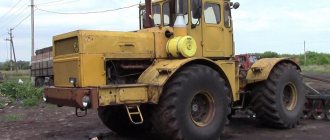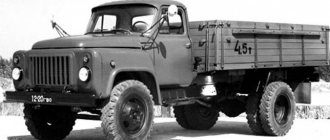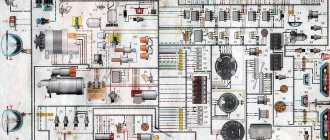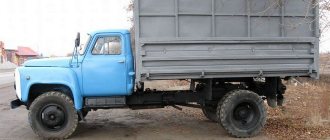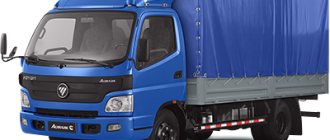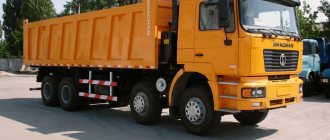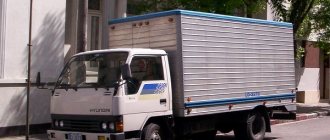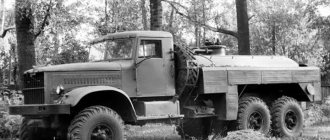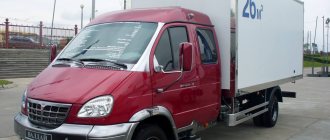The Likhachev plant is one of the oldest automobile manufacturing enterprises in Russia. ZIL brand trucks gained great popularity and were produced in huge, mass quantities.
This article will describe the main features of tires for ZIL vehicles, provide step-by-step instructions for disassembling wheels on a ZIL-131, provide a description of the ZIL-132 all-terrain vehicle with arched wheels, and also provide detailed characteristics of wheels for the ZIL-130.
Wheel for ZIL
How to disassemble a wheel on a ZIL-131
The vehicle is equipped with interchangeable disc wheels with the wheel rim size ZIL 131 - 228G508, with cut bead rings. Tire size for ZIL-131 is 12.00R20 or 12.00-20 (for radial and diagonal cords, respectively). That is, the wheel diameter for ZIL-131 is 20 inches.
Important!
All manipulations to remove the disk from the tire must be carried out only with the air deflated from the tire.
When disassembling manually, you must perform the following operations:
- Remove the wheel from the car.
- Deflate all the air from the tire and place the wheel on a flat horizontal area with the rim locking part facing down.
- Remove the inner bead of the tire from the rim. To do this you will need two mounts. The curved end of the blade must be inserted between the bead ring and the rim of the disc and pull the bead ring down. Insert a flat-end pry bar into the resulting space and pull out the first pry bar. Thus, sequentially moving along the entire circumference of the rim, remove one bead of the tire from the rim.
- Turn the tire over to the other side and remove the second bead from the rim in the same way.
- Remove the lock and bead rings. To do this, insert a flat pry bar into the gap at the end of the locking ring and use a second spatula to pry it out.
- Next, you need to stand with both feet on the sides opposite the valve hole. Insert two spatulas with flat ends into this zone at a distance of 15-20 cm from each other. Pull the prybars to the bottom and move part of the tire bead out. Continue to hold the dismantled part of the tire with one pry bar, move the other at a distance of 10 cm and move another part of the tire out. Repeating these steps, completely remove one bead of the tire.
- Place the wheel vertically. Remove the disc from the tire.
You might be interested in this About winter tires for the Kia Rio - which tires to choose
Beading of wheels on ZIL-131
Thus, the ZIL-131 rubber is removed from the disk.
How much does one stamped disk weigh?
What is the difference in kilograms between stamped, cast and forged wheels, the scale will show. A stamped iron wheel in size 7.0×17 weighs. A cast alloy wheel of the same size weighs 10 kg 780 g. The weight of a forged alloy wheel in size 7.5×17 is 9 kg 700 g.
Interesting materials:
Who should confess to? Who doesn't need a tachograph from November 1, 2019? Who should not read namaz? Who shouldn't have citramon? Who does the chief accountant report directly to? Who needs financial analysis? Who needs palliative care? Who does the administrator report to? Who does the Federal Antimonopoly Service report to? Who does the Federal Service report to?
Useful tips
For disassembling and assembling wheels, the tool kit supplied with the vehicle includes two mounting blades: one with a flat end and one with a curved grip. The latter simultaneously serves as a jack lever.
According to the operating instructions and repair manual for the 131st car, in order to preserve the tire beads and facilitate all operations, the removal of a tire from a wheel can only be carried out at a specialized stand for tire removal and only in exceptional cases - manually.
Dismantling the wheels, due to the size of the tires for the ZIL 131, is a very labor-intensive task. It will be extremely difficult to cope with this situation alone. In addition, many old wheels sit very tightly on the rim. To disassemble them manually, a sledgehammer and angles are used to help.
Important!
It is strictly forbidden to try to remove the tire bead by hitting the lock ring with a sledgehammer, since during these manipulations the impact force is transferred by the ring not to the tire, but to the lock groove of the rim, which will only cause damage to the ring.
Characteristics
A huge selection of additional equipment was offered for ZIL trucks, which made the vehicle universal for all areas of operation. The machine could be used to transport goods, and the version with a crane could be used for construction and utility purposes.
The truck was equipped with a 6.0 liter V-shaped engine with 8 cylinders and a two-chamber carburetor. Output power of 150 hp. it was enough for a load capacity of 6 tons, and it allowed it to confidently perform the functions of a medium-tonnage truck.
Further modifications of the truck were produced with a modified version of the ZIL-130 engine. Most improvements consisted of adapting the motor to various conditions (faster acceleration, greater load capacity, etc.).
Modified version of the ZIL-130 engine
ZIL-132 6x6 with arched tires
ZIL-132 is a legendary Soviet all-terrain vehicle with a 6x6 wheel arrangement. The car is equipped with three equidistant axles, which are located at a distance of 2.5 meters from each other, and wide arched tires so that the heavy all-terrain vehicle (the vehicle weighs almost 10 tons) does not fall into the ground. Thus, the 132nd all-terrain vehicle, created in the early 60s of the 20th century, was opposed to tracked vehicles, since before its creation only tracked all-terrain vehicles had high maneuverability.
Additional Information!
Arch tires are a type of all-terrain tire with a wide arch-shaped profile.
The volumetric tires also provided a soft ride, since the suspension, which is usually responsible for this function, was absent: the car was built with a rigid mount of the discs to the frame without an elastic element.
ZIL-132
The ZIL-132 was equipped with eight-ply arched tires with an “oblique dissected Christmas tree” tread pattern. The front and rear wheels are swivel and are equipped with hydraulic boosters for these purposes.
The air pressure in the tires was adjusted depending on the condition of the road surface. To do this, the all-terrain vehicle was equipped with a central system for regulating air pressure in the tires. The minimum pressure was used when moving in particularly difficult off-road conditions. It was possible to change the tire pressure on the left and right side independently of each other.
On a note!
Thus, the ZIL-132 car, equipped with arched tires, was able to overcome snow-covered areas 1 meter deep and entered a ford 1.5 meters deep.
| ZIL-431410 | ZIL-431510 | |
| Load capacity, kg | 6000 | 6000 |
| Curb weight, kg | 4175 | 4550 |
| Including: | ||
| to the front axle | 2005 | 2140 |
| to the rear axle | 2170 | 2410 |
| Total weight, kg | 10400 | 10775 |
| Including: | ||
| to the front axle | 2510 | 2845 |
| to the rear axle | 7890 | 7930 |
| Gross trailer weight, kg | 80001 | 80001 |
| Max. vehicle speed, km/h | 90 | 90 |
| The same, road trains | 80 | 80 |
| Vehicle acceleration time to 60 km/h, s | 37 | 37 |
| Max. climbability by car, % | 31 | 31 |
| The same, by road train | 16 | 16 |
| Vehicle run-out from 50 km/h, m | 750 | 750 |
| Car braking distance from 50 km/h, m | 25 | 25 |
| The same, road trains | 26,5 | 26,5 |
| Control fuel consumption, l/100 km, vehicle: | ||
| at 60 km/h | 25,8 | 25,8 |
| at 80 km/h | 32,2 | 32,2 |
| The same, road trains: | ||
| at 60 km/h | 33 | 33 |
| at 80 km/h | 43 | 43 |
| Turning radius, m: | ||
| on the outer wheel | 8,3 | 9,5 |
| overall | 8,9 | 10,1 |
Engine.
Maud. ZIL-508.10, petrol, V-shape. (900), 8-cyl., 100×95 mm, 6.0 l, compression ratio 7.1, operating order 1-5-4-2-6-3-7-8, power 110 kW (150 hp) s.) at 3200 rpm, torque 402 Nm (41 kgf-m), fuel pump B10 - diaphragm, K-90 carburetor with forced idle economizer or K-96, K-88AT, K-88AM, air filter - inertial oil filter VM-16 or VM-21.
Transmission.
The clutch is single-plate, with peripheral pressure springs, the release drive is mechanical. Transmission - 5-speed. with synchronizers in II, III, IV and V gears, gear. numbers: I-7.44; II-4.10; III-2.29; IV-1.47; V-1.00; ZX-7.09. Cardan transmission consists of two consecutive shafts with an intermediate support. The main gear is a single hypoid, gear. number 6.33. A drive axle with a double bevel-cylindrical main gear can be installed. number 6.32.
Wheels and tires.
Wheels - disc, rim 7.0-20, fastening with 8 studs. Tires 9.00R20 (260R508) mod. I-N142B-1 or 0-40BM-1, Installation of tires mod. I-252B or VI-244. Air pressure, kgf/cm. sq.: ZIL-431410 - tires I-N142B-1 and O-40BM-1 - front - 4.0, rear - 6.3; tires I-252B and VI-244 - front - 3.0, rear - 5.8; ZIL-431510 - tires I-N142B-1 and O-40BM-1 - front - 4.5, rear - 5.3; tires I-252B and VI-244 - front - 3.5, rear - 5.8. The number of ears is 6+1.
Suspension.
The front is on two semi-elliptic springs with rear sliding ends and shock absorbers; the rear one is on two main and two additional semi-elliptic springs, the ends of the additional springs and the rear ends of the main ones are sliding.
Brakes.
The service brake system is with drum mechanisms (diameter 420 mm, width of the front linings 70, rear linings 140 mm, cam release) with a dual-circuit pneumatic drive, with a brake force regulator. Brake chambers: front - type 16, rear - type 24/24 with spring energy accumulators. The parking brake is applied to the brakes of the rear wheels from spring energy accumulators, the drive is pneumatic. The spare brake system is combined with the parking one. The trailer brake drive is combined (two- and single-wire). Upon request, vehicles can be equipped with a brake drive without separation along the axles and with a single-line drive for trailer brakes (ZIL-130-80 vehicle brakes). There is an alcohol fuse against condensate freezing.
Steering.
The steering mechanism is a screw with a ball nut on circulating balls and a piston-rack that engages with the toothed sector of the bipod shaft, the hydraulic booster is built-in, gear number 20, oil pressure in the booster is 65-75 kgf/cm. sq.
Electrical equipment.
Voltage 12 V, ac. battery 6ST-90EM, generator 32.3701 with voltage regulator 201.3702, starter ST230-K1, ignition distributor 46.3706 with centrifugal and vacuum regulators, ignition coil B114-B, transistor switch TK102-A, spark plugs A11. Some vehicles may be equipped with a contactless ignition system.
Filling volumes and recommended operating materials.
Fuel tank - 170 l, gasoline A-76; cooling system - 26l, water or antifreeze - A40, A65; engine lubrication system - 8.5 l, all-season up to minus 30°C oil M-6/10V (DV-ASZp-10V) and M-8V, at temperatures below minus 30°C - oil ASZp-6 (M-4/ 6B); power steering - 2.75 l, all-season oil grade P; gearbox - 5.1 l, all-season oil TSp-15K, substitute - oil TAP-15V, at temperatures below minus 30°C oil TSp-10; hypoid final drive housing - 10.5 l, all-season hypoid gear oil TSp-14 gip, at temperatures below minus 30°C oil TSz-9 gip; two-stage final drive housing - 4.5 l, gearbox oil; shock absorbers - 2×0.41 l, liquid AZh-12T; windshield washer reservoir - 2.7 l, NIISS-4 liquid mixed with water; fuse against condensate freezing - 0.2 l, ethyl alcohol.
Weights of ZIL-431410 vehicle units
(in kg). Power unit assembly - 640; engine - 500; gearbox (without parking brake) - 98; cooling system radiator - 20; cardan shaft - 36; rear axle assembly with brake mechanisms - 477; front axle assembly with brake mechanisms - 243; springs: front - 37; rear - 70; additional - 25; wheel with tire - 93; frame with buffer and towing device - 430; cabin - 280; tail (facing with wings and mudguards, hood) - 70; platform - 580.
Review and technical characteristics of ZIL-130
The car belonged to the medium-duty class. Its carrying capacity was 5–6 tons, that is, it occupied an intermediate position between the lighter GAZ-53 and the heavy MAZ, KrAZ and others. This niche turned out to be in great demand in the national economy, and a successful combination of characteristics allowed the “one hundred and thirtieth” to stay on the assembly line for 30 years.
The new model was equipped with a gasoline carburetor engine, which for a long time determined the characteristic features of the car, its pros and cons. This is smooth operation and ease of repair and adjustment on the one hand, and excessive gluttony for fuel on the other.
ZIL could carry more cargo than it weighed itself, which at that time was considered a very good indicator. The towed trailer weight of truck tractors was 8 tons, and the maximum speed was 90 km/h (empty, of course). No one drove cars at such speeds back then.
The relatively short wheelbase allowed the truck to turn in a circle with a radius of less than 9 m. Gable rear tires, a strong frame and axle sometimes made it possible to overload the vehicle within reasonable limits with virtually no loss of performance.
In the Union, the new ZIL attracted attention with its coloring - a sky-blue cabin and a white front end.
Branded color ZIL-130
All previous trucks that worked in the national economy had a protective color, dark khaki, so that they could be used for military purposes without repainting. Thus, the role of the 130th model was initially peaceful, and the all-wheel drive ZIL-131 model with completely different characteristics was subsequently created for the army. The blue and white combination became the calling card of the “one hundred and thirtieth” for a long time.
